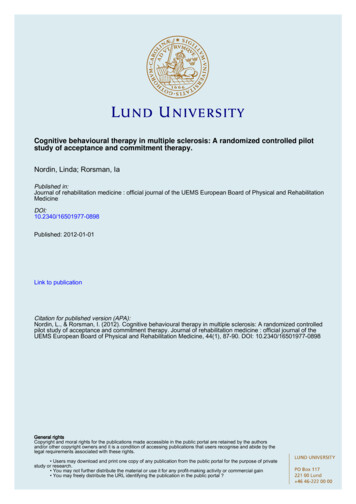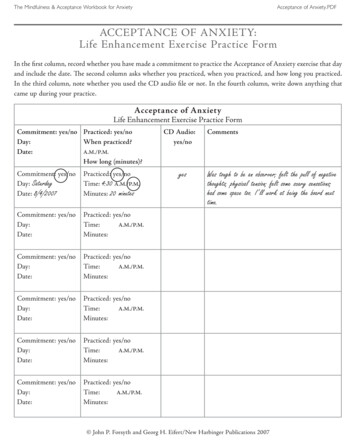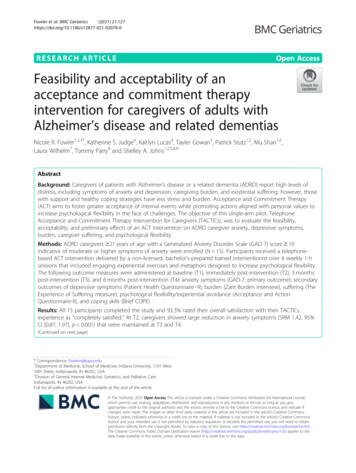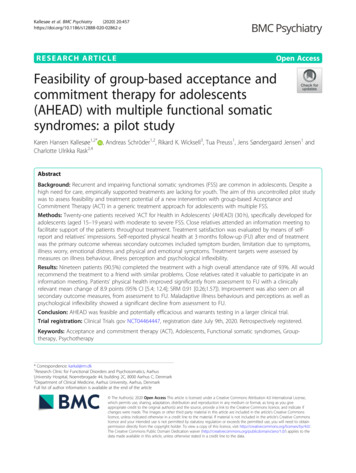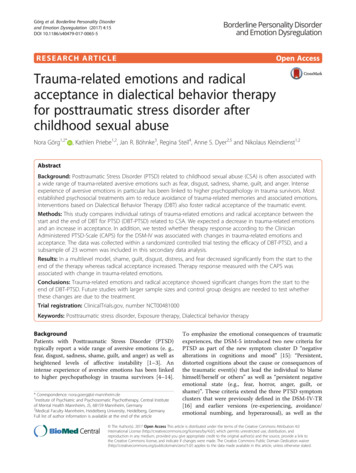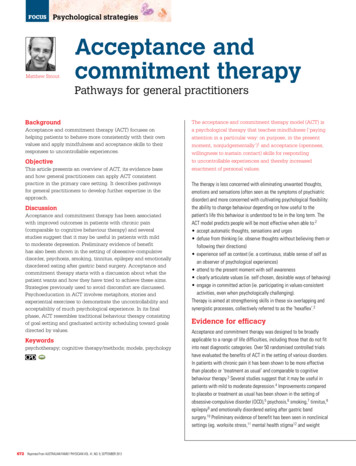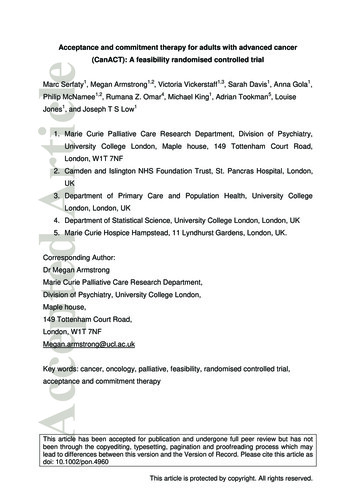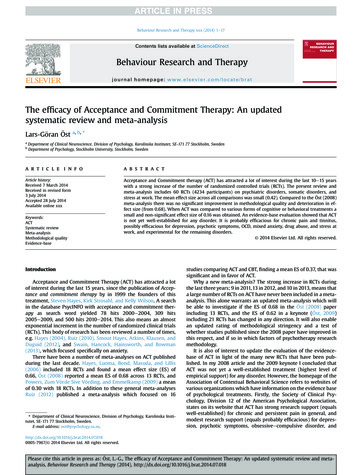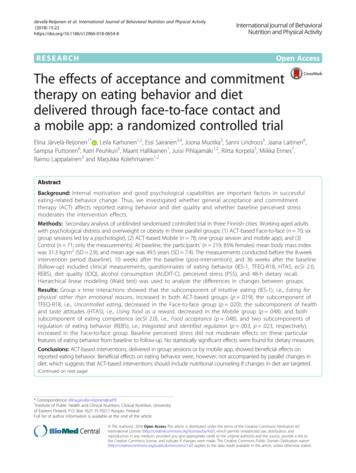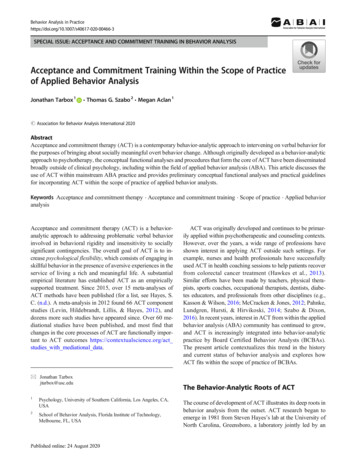
Transcription
Behavior Analysis in SPECIAL ISSUE: ACCEPTANCE AND COMMITMENT TRAINING IN BEHAVIOR ANALYSISAcceptance and Commitment Training Within the Scope of Practiceof Applied Behavior AnalysisJonathan Tarbox 1&Thomas G. Szabo 2 & Megan Aclan 1# Association for Behavior Analysis International 2020AbstractAcceptance and commitment therapy (ACT) is a contemporary behavior-analytic approach to intervening on verbal behavior forthe purposes of bringing about socially meaningful overt behavior change. Although originally developed as a behavior-analyticapproach to psychotherapy, the conceptual functional analyses and procedures that form the core of ACT have been disseminatedbroadly outside of clinical psychology, including within the field of applied behavior analysis (ABA). This article discusses theuse of ACT within mainstream ABA practice and provides preliminary conceptual functional analyses and practical guidelinesfor incorporating ACT within the scope of practice of applied behavior analysts.Keywords Acceptance and commitment therapy . Acceptance and commitment training . Scope of practice . Applied behavioranalysisAcceptance and commitment therapy (ACT) is a behavioranalytic approach to addressing problematic verbal behaviorinvolved in behavioral rigidity and insensitivity to sociallysignificant contingencies. The overall goal of ACT is to increase psychological flexibility, which consists of engaging inskillful behavior in the presence of aversive experiences in theservice of living a rich and meaningful life. A substantialempirical literature has established ACT as an empiricallysupported treatment. Since 2015, over 15 meta-analyses ofACT methods have been published (for a list, see Hayes, S.C. (n.d.). A meta-analysis in 2012 found 66 ACT componentstudies (Levin, Hildebrandt, Lillis, & Hayes, 2012), anddozens more such studies have appeared since. Over 60 mediational studies have been published, and most find thatchanges in the core processes of ACT are functionally important to ACT outcomes https://contextualscience.org/actstudies with mediational data.* Jonathan Tarboxjtarbox@usc.edu12Psychology, University of Southern California, Los Angeles, CA,USASchool of Behavior Analysis, Florida Institute of Technology,Melbourne, FL, USAACT was originally developed and continues to be primarily applied within psychotherapeutic and counseling contexts.However, over the years, a wide range of professions haveshown interest in applying ACT outside such settings. Forexample, nurses and health professionals have successfullyused ACT in health coaching sessions to help patients recoverfrom colorectal cancer treatment (Hawkes et al., 2013).Similar efforts have been made by teachers, physical therapists, sports coaches, occupational therapists, dentists, diabetes educators, and professionals from other disciplines (e.g.,Kasson & Wilson, 2016; McCracken & Jones, 2012; Pahnke,Lundgren, Hursti, & Hirvikoski, 2014; Szabo & Dixon,2016). In recent years, interest in ACT from within the appliedbehavior analysis (ABA) community has continued to grow,and ACT is increasingly integrated into behavior-analyticpractice by Board Certified Behavior Analysts (BCBAs).The present article contextualizes this trend in the historyand current status of behavior analysis and explores howACT fits within the scope of practice of BCBAs.The Behavior-Analytic Roots of ACTThe course of development of ACT illustrates its deep roots inbehavior analysis from the outset. ACT research began toemerge in 1981 from Steven Hayes’s lab at the University ofNorth Carolina, Greensboro, a laboratory jointly led by an
Behav Analysis Practiceestablished behavior-analytic basic researcher, AaronBrownstein (see Zettle, 2005, for a historical account). Thisearly ACT research sought to address the repertoirenarrowing effects of verbal rules (e.g., Hayes, Brownstein,Haas, & Greenway, 1986; Hayes, Brownstein, Zettle,Rosenfarb & Korn, 1986). A 1982 talk by Steven Hayes atthe annual convention of the Association for BehaviorAnalysis International (ABAI) on rule-governed behaviorand psychopathology (Hayes, 1982) led to the first ACTworkshop to be held at a scientific meeting. The ABAI workshop, titled “Semantic Therapy, Cognition, Rule-GovernedBehavior, and Psychopathology: A Radical BehavioralApproach” (Hayes, 1983), was followed a year later by whatis arguably the first article on both ACT and relational frametheory (RFT) in the journal Behaviorism (Hayes, 1984). Thefirst extended presentation of RFT quickly followed at ABAIin 1985 (Hayes & Brownstein, 1985).Empirical articles on what would later become ACT soonappeared (e.g., Zettle & Hayes, 1986). However, the initialfocus in the early development of ACT was on empiricalinvestigations of the rigidity of rule-governed behavior andthe link between derived stimulus relations and language development, published in the Journal of the ExperimentalAnalysis of Behavior (e.g., Devany, Hayes, & Nelson, 1986;Hayes, Brownstein, Haas, & Greenway, 1986; Hayes,Brownstein, Zettle, Rosenfarb, & Korn, 1986). As these dataconverged on RFT as a basic behavioral account of humanlanguage and cognition, Hayes and colleagues’ conceptualwork focused on the refinement of radical behaviorism as aphilosophy of science (Hayes, Hayes, & Reese, 1988) to moreadequately address the relation between private events andovert action in a nonmentalistic way (e.g., Hayes &Brownstein, 1986). Over the next 15 years, theoretical andphilosophical foundations were clarified (e.g., Hayes &Hayes, 1992), and ACT was refined and manualized (Hayes,McCurry, Afari, & Wilson, 1991).In the more than 35-year history of the development of ACT,the basic and applied data supporting its implementation as amainstream psychological intervention have flourished. Thereare currently over 300 published randomized controlled trials ofACT Hayes, S.C. (2020). As such, ACT has been listed as anempirically supported treatment approach by Division 12 of theAmerican Psychological Association (2016) and by theDepartment of Veterans Affairs (2016), among other organizations. Data have also been published that are more consistentwith behavior-analytic research methods and intervention focuses. Single-case and time-series analyses demonstrating theeffectiveness of ACT have been published, in addition to several dozen studies utilizing overt behavioral or physiologicalmeasures (e.g., Castro, Rehfeldt, & Root, 2016; Gould,Tarbox, & Coyne, 2018; Szabo, 2019; Szabo, Willis, &Palinski, 2019). This empirical work is increasingly central totopics of concern to most BCBAs. For example, a search of theWeb of Science reveals that ACT has been referred to in 32articles on developmental disabilities or parent training. Indeed,articles in journals published by ABAI over the past 35 yearsinclude 98 references to ACT and 650 references to RFT.There are indications that this body of work is increasinglypenetrating the BCBA practice community. A growing numberof ACT and RFT presentations are evident at ABA conferences,and in 2018, ABAI hosted a 1-day, single-track special event onACT immediately postconference. Commercial ACT trainingworkshops aimed at ABA practitioners, as well as a small number of books on applications of ACT to learners with ASD (themost common population served by ABA practitioners), havealso emerged (Dixon, 2014; Dixon & Paliliunas, 2017). Recentrevisions of BCBA competency standards increasingly point tothe theoretical underpinnings and technologies central to ACT,as will be discussed later in the article. Finally, a chapter on RFTand ACT (Critchfield & Rehfeldt, 2020) was included in themost recent edition of the text Applied Behavior Analysis(Cooper, Heron, & Heward, 2020), which is widely consideredthe classic textbook on ABA.Several contextual factors seem to be contributing to theincreased interest in ACT in behavior analysis. As the numberof practicing BCBAs grows exponentially (from just over6,000 in 2010, to over 33,000 in 2018), so does the demandfor evidence-based behavioral technologies that can meet theincreasingly diverse needs of consumers seeking ABA-basedtreatment services. Practitioners often find themselves addressing complex behavioral repertoires that require innovative, higher level programming that goes beyond what theytypically receive direct training in during the course of theirgraduate studies and supervised fieldwork. BCBAs are taskedwith designing effective programs for (a) establishing anddeveloping the verbal repertoires of clients and (b) addressingproblematic patterns of behavior that tend to emerge with thedevelopment of such repertoires. In addition, the majority of aBCBA’s professional activities involve interacting with individuals with complex verbal repertoires (i.e., parents, teachers,staff, colleagues, and other providers), either directly (duringobservations, training sessions, phone calls, meetings, etc.) orindirectly (via e-mails, treatment plans, written notes, etc.).Thus, a functional understanding of language, as it occurs intypically developing adults, appears critical to a BCBA’s success. In short, the growing interest in ACT by BCBAs seemsto be occasioned by client needs and consequated by its effectiveness in addressing those needs.The growing interest in ACT from within the appliedbehavior-analytic community poses some potential practicaland ethical challenges. ACT as applied within the traditionalscope of practice of BCBAs has not been widely disseminated,and most BCBAs have not had significant training or experiencein ACT or RFT. Some uses and forms of ACT are properly therealm of clinical psychology or other disciplines, but manyothers are perfectly suited to the profession of ABA.
Behav Analysis PracticeACT as ABAThe acronym “ACT” originally stood for “acceptance andcommitment therapy,” but for the last 15 years, the term “acceptance and commitment training” has been used to describeapplications of ACT in nonpsychotherapeutic settings (Hayes,Strosahl, & Wilson, 2011; Hayes et al., 2004). A search viaGoogle Scholar shows that the term “acceptance and commitment training” has appeared over 1,000 times in the world’sscientific literature. Although the term “ACT” continues to beused by a wide range of professions, we will use the acronym“ACTraining” to more clearly distinguish between ACT asapplied in psychotherapeutic or counseling settings and ACTas applied within the scope of practice of BCBAs. We are notsuggesting that the term “ACT” is inappropriate for behavioranalysts. We do, however, seek to emphasize the differencebetween ACT as a training method appropriately integratedinto the work of BCBAs versus ACT utilized by psychotherapy or counseling professions.According to the Behavior Analyst Certification Board(BACB; www.bacb.com), behavior analysis is the “scientificstudy of principles of learning and behavior,” consisting of thebasic natural science of the experimental analysis of behaviorand of the application of that natural science, ABA.Specifically, ABA is defined as a systematic approach forinfluencing socially significant behavior through theapplication of behavioral principles to the identification andmanipulation of reliably related environmental variables.BCBAs provide services to improve organizationalfunctioning (e.g., staff performance, employee training,management and compensation practices), skill deficits (e.g.,communication, social behavior, health and wellnessbehaviors), and socially unacceptable behavior (e.g.,aggression, self-injurious behavior). Thus, our most basicproposition is that ACTraining should be based in the samebasic natural science and explicitly involve the application ofthe behavioral principles that extend from that work to themanipulation of the controlling environment in a way thatimproves socially significant overt behavior. Put simply,ACT as practiced within ABA should meet all of the samestandards that define any other practice within ABA (e.g.,Baer, Wolf, & Risley, 1968), and we discuss many such examples in this article.Linkage to Behavioral PrinciplesABA is characterized, in part, by its commitment to beingconceptually systematic (Baer et al., 1968), meaning that behavior analysts observe and analyze behavior in context anddesign interventions from an understanding of the functionalrelationship between behavior and the environment, in termsof behavioral principles. The importance of remainingconceptually systematic is perhaps even greater whenadapting interventions that were originally developed for practitioners outside of ABA (e.g., ACT interventions). AfterABA practitioners have been substantially trained in thebehavior-analytic conceptual analyses that form the core ofACTraining, they can then both (a) adapt traditional ACTmethods for incorporation into ABA interventions and (b)create their own ACTraining interventions consistent withtheir own client-specific functional assessments.Understanding how ACT works in terms of behavioral principles allows the ABA practitioner to implement ACT functionally, rather than simply implementing procedures as puretechnology. This is consistent with what ABA practitioners dowhen they use more mainstream ABA procedures, such asfunctional communication training, discrete-trial training, ornatural environment training.According to the ACT model, psychological flexibility is theability to contact the present moment regardless of aversivethoughts and feelings based on the situation and one’s personalvalues (Hayes et al., 2004). Specifically, one identifies that thethought or feeling is only temporary and engages in behaviorsthat result in long-term value to one’s life. For instance, a parentmay continue to place a tantrum on extinction, although shefeels uncomfortable when hearing the crying and whining, tobring about more meaningful interactions with her child in thefuture. Psychological flexibility can be conceptualized as involving six functionally defined behavioral repertoires, all ofwhich support one another. These six repertoires are typicallydescribed in “middle-level terms” (i.e., terms that serve to orient the behavior analyst to particular functional relations between the environment and behavior) and comprise the sixpoints of the ACT hexlaflex: acceptance, defusion, present moment attention, self-as-context, values, and committed action(Hayes, Bond, Barnes-Holmes, & Austin, 2006). In what follows, we describe each of the six dimensions in two ways: (a)as repertoires of behavior that ACT is designed to strengthenand (b) as procedures used to strengthen these repertoires(much the same as “functional communication training” refersboth to relations of reinforcement for communication and extinction for challenging behavior and to the procedures used tobring those relations about).ValuesIncreasing valued living is described as the primary goal ofACT (Hayes et al., 2011). Behaviorally, values can be conceptually analyzed to be rules that function as verbal motivating operations that increase or decrease the effectiveness ofstimuli as reinforcers or punishers, thereby supporting overtbehaviors that produce those stimuli. Consider a BCBA whohas been avoiding parent training sessions and engaging innegative thoughts (i.e., private verbal behavior) such as “Ican’t believe I have to work with another uncooperative
Behav Analysis Practiceparent.” The BCBA may reflect on the situation by clarifyingher values. For example, she might assert, “I am going to dowhatever I can to ensure this child receives the best care possible, including taking on the challenge of supporting the parents who may not want to do everything I recommend.” If thissmall values intervention is effective in helping the BCBAengage the parent, the BCBA may then take the opportunityto implement a values intervention with the parent to help theparent move toward her values. For example, the BCBA couldsuggest the parent write her own unique values statement,such as “I care about being an advocate for my child.” Thesepractices help transform the stimulus function of events thatare otherwise aversive and that evoke avoidance responses.When the BCBA or parent in this example articulates an important value, aversive stimuli that participate in equivalencenetworks with the stated value acquire new, more appetitivestimulus functions. In the context of freshly articulated values,the parent is more likely to ask questions in individualizededucation plan meetings and the BCBA to make recommendations, even when they might be challenged by the parent.Overall, values interventions may enable a BCBA to addpowerful appetitive functions (or intermediary reinforcers) toan otherwise aversive situation, providing a parent, staff member, client, or teacher with the motivation he or she needs topersevere in the face of adversity. Values interventions thussupport rule-following repertoires that are oriented towardlarger, longer term positive reinforcers, versus short-term escape (Blackledge & Drake, 2013). For example, during anintake meeting, the BCBA might engage the parent in a valuesexercise such as “The Three Wishes” (Gould et al., 2018),where the BCBA asks the parent, “If you could have anythingin the world for your child, what would it be?” to which theparent might respond with something like “I want my child tobe able to express herself and to be safe.” The BCBA mightsubsequently link all treatment recommendations back tothose parent values, potentially increasing the likelihood ofsecuring buy-in and commitment to treatment protocols(e.g., “I want to introduce this augmentative and alternativecommunication [AAC] device in the service of helpingShanice express her needs and be understood, no matter whereshe is or who she is talking to.”), as well as reconnecting theparent with his or her values when things get difficult (e.g., “Iam willing to go through this, in the service of Shanice beingsafe from harm, happy, and independent in the future.”).Present Moment AttentionPresent moment attention (often referred to as “mindfulness”or “present moment awareness” in the ACT literature) involves strengthening one’s repertoire of attending to stimuliin the present moment, while weakening one’s repertoire ofattending to one’s own verbal behavior with respect to past,future, or imagined events. Present moment attention trainingthus aims to increase sensitivity to environmental contingencies and weaken unhelpful sources of verbal stimulus control.In practice, this involves evoking and reinforcing attention todifferent aspects of immediate experience. For example, parents might be taught to discriminate when they are “in theworld” (i.e., in contact with direct contingencies) versus “intheir heads” (i.e., primarily attending to private verbal stimuli,e.g., “I can’t do this”). The purpose of this training is to facilitate contact with overt environmental stimuli (e.g., the childseeking out the AAC device) that might occasion more adaptive parenting responses that support the child’s treatment(e.g., reinforcing the child’s use of functional communication), as opposed to engaging in avoidance (e.g., obsessivelyresearching treatment articles online) in the presence of aversive private stimuli (e.g., feelings of grief about the child’sdiagnosis and worry about the future).Furthermore, present moment procedures involve trainingone to pay attention to one’s own attending behavior. In caseswhere one notices one’s attention wander, one redirects one’sown attending behavior back to present moment stimuli. Putdifferently, one learns to tact one’s own attending behavior,and the occasion of tacting wandering attention, itself, becomes a discriminative stimulus for redirecting one’s ownattention back to the present moment, thus comprising a secondary repertoire of self-managing one’s own ongoing attending behavior (Skinner, 1953, Chapter 15). An everyday example of such behavior that is likely familiar to anyone whodrives an automobile is when one suddenly notices that oneis not looking at the road while driving and then redirectsone’s own attention back to the road.AcceptanceAcceptance can be thought of as approach behavior (or theabsence of avoidance or escape) in the presence of aversivestimuli, thus creating a context for more varied and potentiallymore adaptive behaviors to occur and then contact naturalreinforcers. Thus, an ABA practitioner might train acceptanceanytime avoidance is interfering with the task at hand. In practice, this involves weakening rule-governed, negatively reinforced repertoires by directly evoking and reinforcing the ability to approach previously aversive events (public and private). For example, in the context of parent training, aBCBA might train a parent in acceptance while followingthrough with an extinction procedure aimed at producinglong-term positive (i.e., values-directed) outcomes, insteadof engaging in typical avoidance behavior when the parentcontacts aversive private events in the moment (the stress ofseeing and hearing the child in distress).In the context of parent training, BCBAs can model acceptance by saying things like “I know I’m supposed to be theexpert, but honestly, doing extinction is really hard for me too.And it’s the stand that I’m willing to take for your child.”
Behav Analysis PracticeBCBAs can directly reinforce parents’ acceptance behavior bycreating a supportive context for parents to choose difficultactions and then directly reinforce when they do so. For example, the BCBA might suggest during parent training, “I cansee this is frightening to you. You’re worried about getting itwrong. How about we run the extinction procedure togethertoday? You’re not alone. I’ll be here. We’re in this together.”As the parent begins to conduct the procedure, the BCBAmight respond by saying, “I know that wasn’t an easy choice,and I’m impressed. Through your actions, you are showingthat you are willing to do pretty much whatever it takes to helpyour child, and that’s pretty awesome. Let’s do this!”In the case of a BCBA applying ACT procedures to one’sown self-management, if the BCBA is struggling with a challenging parent training situation and experiences aversive private events (e.g., feelings of frustration and thoughts such as“I can’t do this anymore!” or “This is pointless.”), rather thanavoiding returning a parent’s phone call, the BCBA mighttake a few minutes to purposefully observe his or her feelingsof frustration and the difficult thoughts he is she is having, andthereby “allow them to be there.” The BCBA might writedown his or her thoughts on a Post-it and then state his orher willingness to talk with the parent by connecting to values(“Even though it feels pointless and frustrating, I’m willing tocall this parent because I care about doing the best I can forthis family, and I care about being a compassionate, responsive behavior analyst.”). Hence, a previously aversive situation now becomes an opportunity to contact reinforcement bybehaving in a values-consistent manner.DefusionFrom a commonsense perspective, defusion is the embodiment of perhaps the most central of behavioral concepts:The mind does not control behavior. In contrast to how ourmentalistic society has trained us all to believe that the mindcauses behavior, and therefore that we should take ourthoughts very seriously, defusion procedures are about teaching people to notice their private events for what they reallyare: just more stimuli in their environment. A behavioral conceptual analysis of defusion is considerably more complexand involves rule-governed behavior. The problem to whichdefusion is directed is referred to as “fusion” in the ACTliterature and means overly rigid control of behavior by rules.Defusion, then, refers to a weakening of overly rigid rulecontrol over behavior, such that other functions (verballyand nonverbally established) can come to bear. Defusion procedures thus seek to disrupt narrow, inflexible functions of aperson’s private verbal stimuli (i.e., thoughts), so that abroader, more flexible repertoire of responding to thosethoughts as private stimuli might be established. Thus, anABA practitioner might train defusion anytime thoughts(i.e., private verbal stimuli) dominate attention, producingunworkable patterns of behavior. In practice, this involvestraining attention to the process of thinking. For example, ifa client is continuously distracted from attending to schoolactivities by thoughts that she is going to fail or “is dumb,”the BCBA might teach the child to playfully visualize thinking these negative thoughts as falling down a rabbit hole.Rather than continuing to fall down the hole, the student istaught to verbally “catch herself from dropping farther into thehole.” The student is thus taught to tact her negative thoughtsas a “rabbit hole,” a context in which to reorient attention backto the task at hand.Of course, for less verbally adept students, such talk is tooabstract. With such students, it may be helpful to physicalizemetaphors. In the previous example, the BCBA might teachthe child to respond to her own negative self-talk by literallyspreading her arms out to “stop” herself. If the social contextof the classroom is not appropriate for the student to spreadher arms wide, she could be taught to subtly spread her handsout slightly. In each case, responding to one’s own negativeself-talk metaphorically can create a context for more variablebehavior, rather than simply avoiding difficult social or academic situations that evoke the negative self-talk.Defusion procedures generally disrupt the function of unhelpful rules by either adding neutral functions to those rulesor by adding humorous functions. An example of adding aneutral function is imagining one’s thoughts as a radio stuckon “negative FM.” For example, consider a parent who tellsthe BCBA that he or she is having the thought “I can’t doextinction.” The BCBA might say something likeI know doing extinction is unreasonably difficult, andwhen we do it, our minds will inevitably tell us stuff thatisn’t helpful. But what if it was possible to just noticeour thoughts as just another thing in our environment,annoying and painful, but not always as directions thatwe have to follow. If you are willing, try taking a minuteand imagining your extinction mind is like a radio that’sstuck on the station “I can’t FM.” It would be reallyirritating for your radio to be stuck like that, but youwouldn’t have to do whatever the DJ said, right? Ifyou had to, you could keep doing what mattered, evenwith a really negative DJ talking in the background.Maybe it’s worth trying to imagine that while you implement extinction.Of course, there is nothing special about the metaphor of astuck radio station. The BCBA might use any other metaphorthat is a familiar example of repeating messages that one doesnot necessarily have to listen to—for example, a stock marketticker tape, a sign being trailed by an airplane in the sky, or abroken record player.An example of a defusion exercise that adds humorous functions to maladaptive verbal stimuli is where the
Behav Analysis PracticeBCBA asks the person to repeat the problematic thoughts(i.e., verbal behavior) in a silly voice. For example, if achild with ASD is having difficulty with losing a boardgame and says, “I can’t lose this game!” the BCBAmight say something likeLook, I hate losing too. If you can win, awesome, thenwin. But when I can’t win, one thing that helps me is torepeat my thought back to myself but in the voice ofYoda from Star Wars. If I’m losing a game, and it’sdriving me nuts, I might just say “Lose this game, Ican’t!” [while talking in a silly accent that resemblesthe Yoda character]. Are you willing to give it a shot?Try it—just say something like Yoda.At first the BCBA may have to provide echoic prompts andcontrived reinforcement to teach the child to say his thoughtsin a “Yoda voice,” and then fade prompts and reinforcementas the child continues to use the newly learned defusion skill.There is nothing about silly voices, per se, that are necessaryfor defusion to work. What matters is that, functionally, thepractitioner helps the learner engage in some other more flexible and varied behavior in the presence of whatever rules areevoking avoidant behavior. In lay terms, defusion is aboutteaching learners to “not take their own minds so seriously.”Self-as-ContextSelf-as-context describes an awareness of oneself as the context for all of one’s experiences (i.e., observing that one’sbehavior is distinct from other external and internal events;Levin et al., 2012). Behavior analytically, self-as-contextmight be thought of as a flexible perspective-taking repertoire.Viewed from the standpoint of RFT, self-as-context involvestraining flexible deictic relations of I/you, here/there, and now/then. In this way, self-as-context procedures involve shapingflexible, self-directed verbal behavior in the presence of private events that vary across time (e.g., memories of the pastand concerns for the future), place (e.g., different situations,relationships, roles), and person (e.g., different perspectiveson the same event). Thus, an ABA practitioner might trainself-as-context anytime rules about the self (i.e., in lay terms,self-conceptualizations like roles, relationships, characteristics, and evaluations) limit flexibility and hinder valuesdirected overt behavior. For example, if a client defends hisdisruptive behavior by describing himself as a “class clown,”the BCBA might teach the child to consider (a) the differentways he might describe himself in different situations or atdifferent times in his life and (b) the different ways others inhis life (e.g., parent, favorite teacher, or friend) might describehim based on what they see. Similarly, if a father resists abehavior intervention plan and says something like “I’m justa softy; I can’t be stric
Keywords Acceptance and commitment therapy . Acceptance and commitment training . Scope of practice . Applied behavior analysis Acceptance and commitment therapy (ACT) is a behavior-analytic approach to addressing problematic verbal behavior involved in behavioral rigidity and insensitivity to socially significant contingencies.
